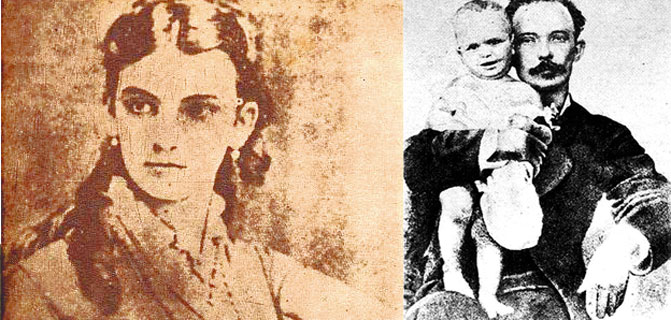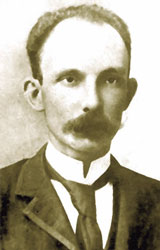
Where did this man find the time to do everything that he did?
He united the pro-independence forces, founded a political party, and organized the war against Spain. From the age of 17, when he was deported from Cuba after serving prison time and hard labourmdash;as a minormdash;he lived most of his live in exile.
He earned two university degrees in Spain; worked as a lawyer and bookkeeper; taught in schools in several South American republics; and represented those countries at international conferences. Speaker. Journalist always. He created and directed a newspaper, Patria, and published several magazines, including The Golden Age, for the children of America, filling it with his writing, from cover to cover.
He wrote directly in English for U.S. newspapers. He did theatre, wrote a novel. As a poet, he is one of the greatest in the Spanish language, a forerunner of modernism, even though his work could not be classified into any particular school while he was alivehellip;. His complete worksmdash;chronicles, articles, essays, letters, speeches, etc.mdash;fill almost 30 volumes of nearly 300 pages each.
 Where did this man, who only lived for 42 years, find the time to do everything that he did? Did his political and professional work leave him time for a private life? Did he love?
Where did this man, who only lived for 42 years, find the time to do everything that he did? Did his political and professional work leave him time for a private life? Did he love?
Martí was a man who needed warmth and affection. Only in the affairs of love or action was he able to find the right temperature," says Cuban writer Jorge Mañach in Martí el Apóstol (Martí the Apostle), his magnificent biography of Cubarsquo;s national hero. Martí had a difficult marriage that produced a son, to whom he dedicated his splendid book of poetry, Ismaelillo. However, before and after that marriage, and sometimes in parallel, he allowed other women to enter the fervour of his life as an exile.
Rosario de la Peña, known as The Muse," or the George Sand of Mexico, was among the first. And Mexican actress Concha Padilla, with whom he experienced a romance of brusque alternatives of beatitude and blues."
Concha was very jealous and had good reason. Doña Leonor, Martírsquo;s mother, did not look kindly upon his romance with Concha Padilla. Many of his friends were also unsympathetic. One of these buddies trained Martírsquo;s eyes on a Cuban woman, Carmen Zayas Bazán, refined and elegant, who would stroll down the Alameda and attract the gazes of all the young men. In any case, another actress later entered the life of the exiled Cuban: Eloisa Aguuml;ero, a Cuban woman who lived in Mexico and was separated from her husband.
 After his turbulent love affair with Concha, Carmen was a haven of tranquility. They became engaged and Martí traveled to Guatemala. There he met María García Granados, the daughter of an ex-president of that country. They were mutually attracted, and he was drawn to that 20-year-old girl with the pale face and the gentle expression, awakening her love.
After his turbulent love affair with Concha, Carmen was a haven of tranquility. They became engaged and Martí traveled to Guatemala. There he met María García Granados, the daughter of an ex-president of that country. They were mutually attracted, and he was drawn to that 20-year-old girl with the pale face and the gentle expression, awakening her love.
She asked him to write a poem for her in her private album. Martí did, and María read it with a heavy heart; he talked about friendship in his verses, not love. He tried to take her hand, and she fled into the house. Martí had said nothing to his Guatemalan friends about his engagement to Carmen, and the poem in Maríarsquo;s album was more of a cruel revelation than a merciful lie. He travelled to Mexico and returned to Guatemala, married. María died. Years later, Martí immortalized her in his poem La niña de Guatemala" (The Guatemalan Girl), one of his most celebrated: hellip;She gave the forgetful one / a perfumed sachet. / He returned, returned married. / She died of lovehellip;."
With Carmen, things went well sometimes but almost always badly. Martí managed to return to Havana, where his son was born, but he was deported again, and from then on the couple would reunite once in a while. When they did so, it was under a diplomatic peace in a household strained by financial hardship and the continuous demands made on Martí by his patriotic ideals. One day Carmen left him forever.
She was a woman, and perhaps sensed that another love, placid and domestic, had replaced elusive love."Because at that time another Carmen, Carmen Miyares, had appeared in the Apostlersquo;s life. And she filled it. She was married to a Cuban, Manuel Mantilla, who was ill with melancholy and paralysis. She was half-Venezuelan and half-Cuban from Santiago; robust, loquacious, friendly.
Much has been said about these romances. Some deny them. He had a fatherrsquo;s love for María, the daughter of Carmen, who shared the name of the Guatemalan girl. The resemblance between Martí and the girl Maria is astonishing when comparing their portraits. Was he her father? Martí used to write María Mantilla letters brimming with affection and advice for when he wouldno longer be alive.
The last of these letters, written weeks earlier, was received by María in New York on May 19, 1895, the same day that Martí fell in battle against the Spanish troops in Cuba. In it, he told her that he carried her portrait over his heart, as a shield against the bullets.